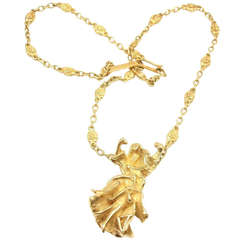Salvador Dali Carmen
Vintage 1970s Spanish Artisan Figurines and Sculptures
Gold, 18k Gold, Yellow Gold
Recent Sales
Vintage 1980s Italian Pendant Necklaces
18k Gold, Yellow Gold
Vintage 1980s American Chain Necklaces
18k Gold
20th Century Italian Pendant Necklaces
18k Gold
Late 20th Century Link Necklaces
18k Gold
Late 20th Century Unknown Link Necklaces
18k Gold
20th Century Spanish More Necklaces
18k Gold
People Also Browsed
21st Century and Contemporary Italian Baroque More Jewelry
Diamond, Pearl, Gold, White Gold
Vintage 1950s Renaissance Revival Choker Necklaces
Diamond, 18k Gold
Vintage 1980s French Artist Pendant Necklaces
Gold Plate, Brass, Bronze, Gilt Metal
Early 20th Century French Belle Époque More Jewelry
Diamond, Platinum
Vintage 1970s Spanish Artisan Figurines and Sculptures
Gold, 18k Gold, Yellow Gold
Vintage 1960s European Retro Signet Rings
18k Gold, 22k Gold, Yellow Gold
Vintage 1980s French Art Deco Charm Bracelets
Gold Plate, Brass, Gilt Metal
20th Century Bangles
Diamond, 18k Gold, Yellow Gold, Enamel
Vintage 1970s Spanish Artisan Figurines and Sculptures
Gold, 18k Gold, Yellow Gold
Vintage 1970s Spanish Artisan Figurines and Sculptures
Gold, 18k Gold, Yellow Gold
Antique 1870s English Gothic Revival Pendant Necklaces
Natural Pearl, Pearl, White Diamond, Diamond, Enamel, Yellow Gold, 18k G...
Early 20th Century French Art Deco Vanity Items
Diamond, Jade, Natural Pearl, Platinum, 18k Gold, Yellow Gold
Vintage 1970s Spanish Artisan Figurines and Sculptures
Gold, 18k Gold, Yellow Gold
Vintage 1970s Spanish Artisan Figurines and Sculptures
Gold, 18k Gold, Yellow Gold
Vintage 1970s Figurines and Sculptures
Gold, 18k Gold
Antique Early 19th Century British Georgian Chandelier Earrings
Diamond, Yellow Gold, Sterling Silver, 18k Gold
Salvador Dalí for sale on 1stDibs
Instantly recognizable by his waxed, upturned mustache, the flamboyant Salvador Dalí is one of modern art’s most distinctive figures. He is also one of the icons of the 20th-century avant-garde Surrealist movement, whose dreamlike images, drawn from the depths of the unconscious, he deployed in paintings, sculptures, prints and fashion, as well as in film collaborations with Luis Buñuel and Alfred Hitchcock.
Dalí was born in Figueres, Catalonia, and even as a youngster, displayed the sensitivity, sharp perception and vivid imagination that would later define his artworks. In these, he conjured childhood memories and employed religious symbols and Freudian imagery like staircases, keys and dripping candles to create unexpected, often shocking pieces.
Dalí's use of hyperrealism in conveying Surrealist symbols and concepts that subvert accepted notions of reality is epitomized in what is perhaps his most recognizable painting, The Persistence of Memory (1931), in which he depicts the fluidity of time through melting clocks, their forms inspired by Camembert cheese melting in the sun. His artistic genius, eccentric personality and eternal quest for fame made him a global celebrity.
“Each morning when I awake, I experience again a supreme pleasure,” he once said. “That of being Salvador Dalí.”
Find original Salvador Dalí paintings, prints, sculptures and other works on 1stDibs.
Finding the Right Necklaces for You
We are fortunate to know much of the world’s long and dazzling history of necklaces, as this type of jewelry was so treasured that it was frequently buried with its owners. Today, Van Cleef necklaces, Tiffany necklaces and Cartier necklaces are some of the most popularly searched designer necklaces on 1stDibs.
Lapis lazuli beads adorned necklaces unearthed from the royal graves at the ancient Iraqi civilization of Sumer, while the excavation of King Tut’s burial chamber revealed a sense of style that led to a frenzy of Art Deco designs, with artisans of the 1920s seeking to emulate the elegant work crafted by Ancient Egypt’s goldsmiths and jewelry makers.
In ancient times, pendant necklaces worn by royalty and nobles conferred wealth and prestige. Today, wearing jewelry is about personal expression: Luxury diamond necklaces exude confidence and can symbolize the celebratory nature of a deep romantic relationship, while paper-clip chain-link necklaces designed by the likes of goldsmith Faye Kim are firmly planted in the past as well as the present. Kim works exclusively with eco-friendly gold, and these fashionable, fun accessories owe to the design of 19th-century watch fobs.
For some, necklaces are thought of as being a solely feminine piece, but this widely loved accessory has been gender-neutral for eons. In fact, just as women rarely took to wearing a single necklace during the Renaissance, men of the era layered chains and valuable pendants atop their bejeweled clothing. In modern times, the free-spirited hippie and counterculture movements of the 1960s saw costume-jewelry designers celebrating self-expression through colorful multistrand necklaces and no shortage of beads, which were worn by anyone and everyone.
Even after all of these years, the necklace remains an irrefutable staple of any complete outfit. Although new trends in jewelry are constantly emerging, the glamour and beauty of the past continue to inform modern styles and designs. In a way, the cyclical history of the necklace differs little from its familiar looped form: The celebrated French jewelry house Van Cleef & Arpels found much inspiration in King Tut, and, now, their Alhambra collection is a go-to for modern royals. Vintage David Webb necklaces — whose work landed him on the cover of Vogue in 1950, two years after opening his Manhattan shop — were likely inspired by the ornamental styles of ancient Greece, Mesopotamia and Egypt.
On 1stDibs, browse top designers like Dior, Chanel and Bulgari, or shop by your favorite style, from eye-catching choker necklaces to understated links to pearl necklaces and more.


